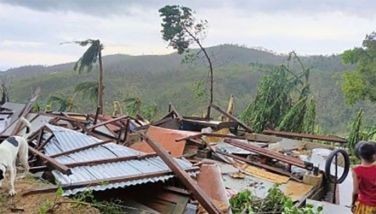P50 M lost in Taal Lake fishkill
February 1, 2006 | 12:00am
LOS BAÑOS, Laguna — The massive fishkill that affected fishcages in Taal Lake last December left losses of up to P50 million, a government research administrator said.
The massive death of tilapia stocks in the inland body of water in Batangas was caused by what Rafael Guerrero III, executive director of the Los Baños-based Department of Science and Technology-Philippine Council for Aquatic and Marine Research and Development (DOST-PCAMRD), called a "lake overturn."
Guerrero explained the natural phenomenon at the Philippine Fisheries Forum 2006, one of the highlights of the council’s 18th anniversary celebration last Monday.
The PCAMRD is a sectoral planning body of the DOST that coordinates the national aquatic and resources research and development system, a network of more than 100 R&D institutions of the government, the academe and industry.
Guerrero said the fishkill wiped out the tilapia stocks of about 80 percent of more than 8,000 fishcages in the 26,000-hectare Taal Lake, the fourth largest in the country.
"A lake overturn takes place in deep inland water bodies like Taal Lake when the cooler mast of water at the surface is forced by winds to displace the warmer and oxygen-poor water mass in the bottom known as ‘hypolimnion,’" a PCAMRD report said.
According to records of the Department of Agriculture-Bureau of Fisheries and Aquatic Resources (DA-BFAR), lake overturns commonly occur during the cold months of December, January and February due to the northeast monsoon (amihan).
Fishkills, though, also occur between April and August.
Researchers of the DA-BFAR and the University of the Philippines Los Baños also attributed the fishkills in Taal Lake in 1993 and 2000 to wind-induced overturns.
During such a phenomenon, the surface water "becomes acidic because of sulfur compounds brought up from the bottom and smells strongly of asupre," they said.
Lake overturns have also occurred in some of the seven lakes in San Pablo City (Laguna), notably the 104-hectare Sampaloc Lake; Alligator Lake in Los Baños; Lake Buhi in Camarines Sur, home to the endangered sinarapan, the world’s smallest extant commercial fish species; and Lake Sebu in South Cotabato.
Lake overturns, according to PCAMRD, cannot be prevented as they naturally occur.
However, fishcage farmers can minimize their losses by scaling down their operations during the cool months and refraining from overfeeding and overstocking so as not to increase the organic load in the lake bottom.
PCAMRD also advised fishfarmers to continually monitor the quality of the water.
The massive death of tilapia stocks in the inland body of water in Batangas was caused by what Rafael Guerrero III, executive director of the Los Baños-based Department of Science and Technology-Philippine Council for Aquatic and Marine Research and Development (DOST-PCAMRD), called a "lake overturn."
Guerrero explained the natural phenomenon at the Philippine Fisheries Forum 2006, one of the highlights of the council’s 18th anniversary celebration last Monday.
The PCAMRD is a sectoral planning body of the DOST that coordinates the national aquatic and resources research and development system, a network of more than 100 R&D institutions of the government, the academe and industry.
Guerrero said the fishkill wiped out the tilapia stocks of about 80 percent of more than 8,000 fishcages in the 26,000-hectare Taal Lake, the fourth largest in the country.
"A lake overturn takes place in deep inland water bodies like Taal Lake when the cooler mast of water at the surface is forced by winds to displace the warmer and oxygen-poor water mass in the bottom known as ‘hypolimnion,’" a PCAMRD report said.
According to records of the Department of Agriculture-Bureau of Fisheries and Aquatic Resources (DA-BFAR), lake overturns commonly occur during the cold months of December, January and February due to the northeast monsoon (amihan).
Fishkills, though, also occur between April and August.
Researchers of the DA-BFAR and the University of the Philippines Los Baños also attributed the fishkills in Taal Lake in 1993 and 2000 to wind-induced overturns.
During such a phenomenon, the surface water "becomes acidic because of sulfur compounds brought up from the bottom and smells strongly of asupre," they said.
Lake overturns have also occurred in some of the seven lakes in San Pablo City (Laguna), notably the 104-hectare Sampaloc Lake; Alligator Lake in Los Baños; Lake Buhi in Camarines Sur, home to the endangered sinarapan, the world’s smallest extant commercial fish species; and Lake Sebu in South Cotabato.
Lake overturns, according to PCAMRD, cannot be prevented as they naturally occur.
However, fishcage farmers can minimize their losses by scaling down their operations during the cool months and refraining from overfeeding and overstocking so as not to increase the organic load in the lake bottom.
PCAMRD also advised fishfarmers to continually monitor the quality of the water.
BrandSpace Articles
<
>
- Latest
- Trending
Trending
Latest
Trending
Latest
Recommended




























